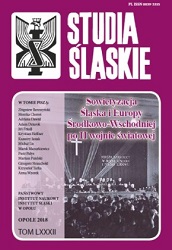Duchowieństwo województwa katowickiego wobec akcji społeczno-politycznych władz komunistycznych w latach 50. XX wieku
The clergy of the diocese of Katowice in face of the political actions taken by the communist authorities in the 1950s
Author(s): Adam DziurokSubject(s): Post-War period (1950 - 1989), History of Communism
Published by: Instytut Śląski
Keywords: Stockholm Appeal;elections to the Sejm and the National Councils; Catholic Church – communist state realtionships;Katowice Voivodeship;
Summary/Abstract: The clergymen in Katowice Voivodeship, similarly as in whole Poland, used to be drawn by thecommunist authorities into various actions of a socio-political character. The apogee of these exertions was the period 1950–1952 and was connected mainly with the so-called peacekeeping action and the elections to the Sejm. The former of these was a specific trap because under pretence of involvement in a fight for peace it concealed an intention to mould a unanimous society under the banner of the PUWP. Priests, following the indications from hierarchs, avoided strictly political involvement that would legitimise the communist authorities. Even if they participated in undertakings endorsed by the party-state authorities, they did so under pressure and without conviction. No such misgivings characterised “priests-patriots” who supported the system and stood at the front line of the fight for peace, not relinquishing thoroughgoing political declarations and supporting almost all of the authorities’ initiatives. In spite of many exertions to gain the clergy’s favour in actions of a socio-political character, only about 20% of the priests from Katowice Voivodeship got involved.The clergymen in Katowice Voivodeship, similarly as in whole Poland, used to be drawn by thecommunist authorities into various actions of a socio-political character. The apogee of these exertions was the period 1950–1952 and was connected mainly with the so-called peacekeeping action and the elections to the Sejm. The former of these was a specific trap because under pretence of involvement in a fight for peace it concealed an intention to mould a unanimous society under the banner of the PUWP. Priests, following the indications from hierarchs, avoided strictly political involvement that would legitimise the communist authorities. Even if they participated in undertakings endorsed by the party-state authorities, they did so under pressure and without conviction. No such misgivings characterised “priests-patriots” who supported the system and stood at the front line of the fight for peace, not relinquishing thoroughgoing political declarations and supporting almost all of the authorities’ initiatives. In spite of many exertions to gain the clergy’s favour in actions of a socio-political character, only about 20% of the priests from Katowice Voivodeship got involved.
Journal: Studia Śląskie
- Issue Year: 2018
- Issue No: 82
- Page Range: 43-62
- Page Count: 20
- Language: Polish

